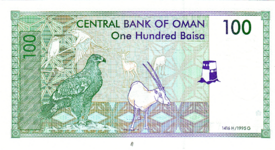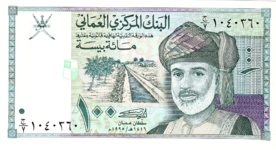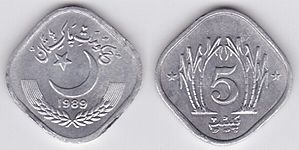Paisa facts for kids
The Paisa is a small unit of money used in several countries. You might also hear it called pice, pesa, poysha, poisha, or baisa. Sometimes, the word "paisa" is just a general way to say "money" or "wealth."
In countries like India, Nepal, and Pakistan, one paisa is worth one-hundredth (1/100) of a rupee. In Bangladesh, the poysha is also one-hundredth (1/100) of a Bangladeshi taka. And in Oman, the baisa is one-thousandth (1/1000) of an Omani rial.
Contents
Where the Word Paisa Comes From
The word paisa comes from an old Sanskrit word, padāṁśa. This word means 'quarter part base'. It combines pada (meaning "foot" or "quarter") and aṁśa (meaning "part" or "unit").
The term pesa was also used in Kenya when it was a colony. Even in the Burmese language, the everyday word for money, paiksan, comes from the Hindi word paisa.
History of the Paisa Coin
Coins from the Chaulukya dynasty (around the 9th to 10th centuries CE) were often called "Gadhaiya Paise." For a long time, until the 1950s in India and Pakistan, the paisa had a different value.
Before 1947 in British India, one paisa was worth three pies. It was also one-fourth (1/4) of an Indian anna. Or, it was one-sixty-fourth (1/64) of a rupee.
Later, countries like India and Pakistan changed their money systems. They moved from an old system to a decimal currency system. This meant that money was now based on units of 100. After this change, one paisa became worth one-hundredth (1/100) of a rupee. For a few years, it was called a naya paisa, meaning "new paisa." This helped people tell it apart from the older paisa that was worth 1/64 of a rupee.
Paisa as a General Term for Money
In many languages, like Hindi, Bengali, Afghan Persian, Urdu, and Nepali, the word paisa often means "money" or "cash."
Long ago, traders traveled across the Arabian Sea. They went between India, Arab regions, and East Africa. This helped spread money terms from the Indian subcontinent and Arabic areas. The word pesa in East African languages, like Swahili, comes from this time.
A modern example is M-Pesa, a mobile money service in Kenya. Its name means "mobile pesa" or "mobile money."
How Paisa is Used Today
The paisa is used in different ways in various countries:
- Poysha = One-hundredth (1/100) of a Bangladeshi taka. These coins are no longer used in daily life.
- Paisa = One-hundredth (1/100) of an Indian rupee. Only 50 paisa coins are technically valid, but they are not really used anymore.
- Paisa = One-hundredth (1/100) of a Nepalese rupee. These coins are also no longer used.
- Baisa = One-thousandth (1/1000) of an Omani rial. These are still in use.
- Paisa = One-hundredth (1/100) of a Pakistani rupee. These coins were officially stopped from being used on October 1, 2014.
Gallery
See also
- Bangladeshi taka
- Indian paisa







